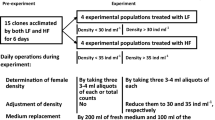Abstract
In laboratory studies, rotifers (Brachionus calyciflorus) were monitored under well-defined environmental conditions at different supply rates of a unicellular algal food (Chlorella vulgaris). Rotifer size frequency distributions are described for conditions of steady-state growth, exponential increase, and starvation. Temporal fluctuations in size-age structure are described for cultures during transient conditions during the approach to a steady state and following step changes in food supply rate. The size structures of the populations displayed definite and reproducible shifts among typical patterns during transient conditions, reflecting the physiological and other dynamic processes that underlay the population dynamics. Size structure probably is a key variable that should be included in models for predicting growth dynamics during transient growth conditions.
Similar content being viewed by others
References
Bennett, W. N. & M. E. Boraas, 1989. Comparison of population dynamics between slow-and fast-growing strains of the rotifer Brachionus calyciflorus in continuous culture. Oecologia 81: 494–500.
Boraas, M. E., 1983. Population dynamics of food-limited rotifers in two-stage chemostat culture. Limnol. Oceanogr. 28: 546–563.
Boraas, M. E., 1993a. Single-stage predator-prey algal-rotifer chemostat culture. ln Walz, N. (ed.), Plankton Regulation Dynamics: Experiments and Models in Rotifer Continuous Culture. Springer-Verlag, Berlin: 51–61.
Boraas, M. E., 1993b. The growth of Brachionus rubens in semicontinuous culture. ln Walz, N. (ed.), Plankton Regulation Dynamics: Experiments and Models in Rotifer Continuous Culture. Springer-Verlag, Berlin: 151–158.
Boraas, M. E. & W. N. Bennett, 1988. Steady-state rotifer growth in a two-stage, computer controlled turbidostat. J. Plankton Res. 10: 1023–1038.
Boraas, M. E., D. B. Seale & J. B. Horton, 1990. Resource competition between two rotifer species (Brachionus rubens and B. calyciflorus): an experimental test of a mechanistic model. J. Plankton Res. 12: 77–87.
Herbert, D., 1958. Some principles of continuous culture. ln Tunevall, G. (ed.), Recent Progress in Microbiology. Blackwell, Oxford: 181–196.
Herbert, D., R. Elsworth & R. C. Telling, 1956. The continuous culture of bacteria: a theoretical and experimental study. J. Gen. Microbiol. 14: 601–622.
McNair, J. N., M. E. Boraas & D. B. Seale, 1998. Size-structure dynamics of the rotifer chemostat: a simple physiologically structured model. Hydrobiologia 387/388 (Dev. Hydrobiol. 134): 469–476.
Monod, J., 1942. Recherches sur la croissance des cultures bacteriennes. Hermann et Cie, Paris. 210 pp.
Monod, J., 1950. La technique de culture continue: theorie et applications. Ann. Inst. Pasteur Paris 79: 390–410.
Novick, A. & L. Szilard, 1950. Description of the chemostat. Science 112: 715–716.
Pirt, S. J., 1975. Principles of Microbe and Cell Cultivation. Blackwell, Oxford. 174 pp.
Tilman, D., 1982. Resource Competition and Community Structure. Princeton University Press, Princeton. 269 pp.
Walz, N., 1993. Regulation models in rotifer chemostats. In Walz, N. (ed.), Plankton Regulation Dynamics: Experiments and Models in Rotifer Continuous Culture. Springer-Verlag, Berlin: 135–150.
Williams, F. M., 1972. Mathematics of microbial populations, with emphasis on open systems. In Deevy, E. S. (ed.), Growth by Intussusception: Ecological Essays in Honor of G. Evelyn Hutchinson. Trans. Conn. Acad. Arts Sci., New Haven, Vol. 44, Archon Books, Hamden, Conn.: 396–426.
Author information
Authors and Affiliations
Rights and permissions
About this article
Cite this article
Boraas, M.E., Seale, D.B., Boxhorn, J.E. et al. Rotifer size distribution changes during transient phases in open cultures. Hydrobiologia 387, 477–482 (1998). https://doi.org/10.1023/A:1017064410487
Issue Date:
DOI: https://doi.org/10.1023/A:1017064410487




